Abstract
The rapidly-labeled polyribosomal RNA component from mouse sarcoma 180 cells is retained on nitrocellulose (Millipore) membrane-filters at high ionic strength. This property is due to the presence of a polynucleotide sequence rich in adenylic acid that resists both T1 and pancreatic RNase digestion. The resistant material shows sedimentation characteristics close to those of transfer RNA. The RNA molecules that contain this material can be separated from the rest of the polysomal RNA by differential phenol extraction with neutral and alkaline Tris buffers. Synthetic poly(A) exhibits the same behavior as the rapidly-labeled polysomal RNA with respect to Millipore binding and phenol fractionation. The characteristics of the rapidly-labeled polysomal RNA component permit its isolation free of ribosomal RNA.
Keywords: poly(A), Millipore
Full text
PDF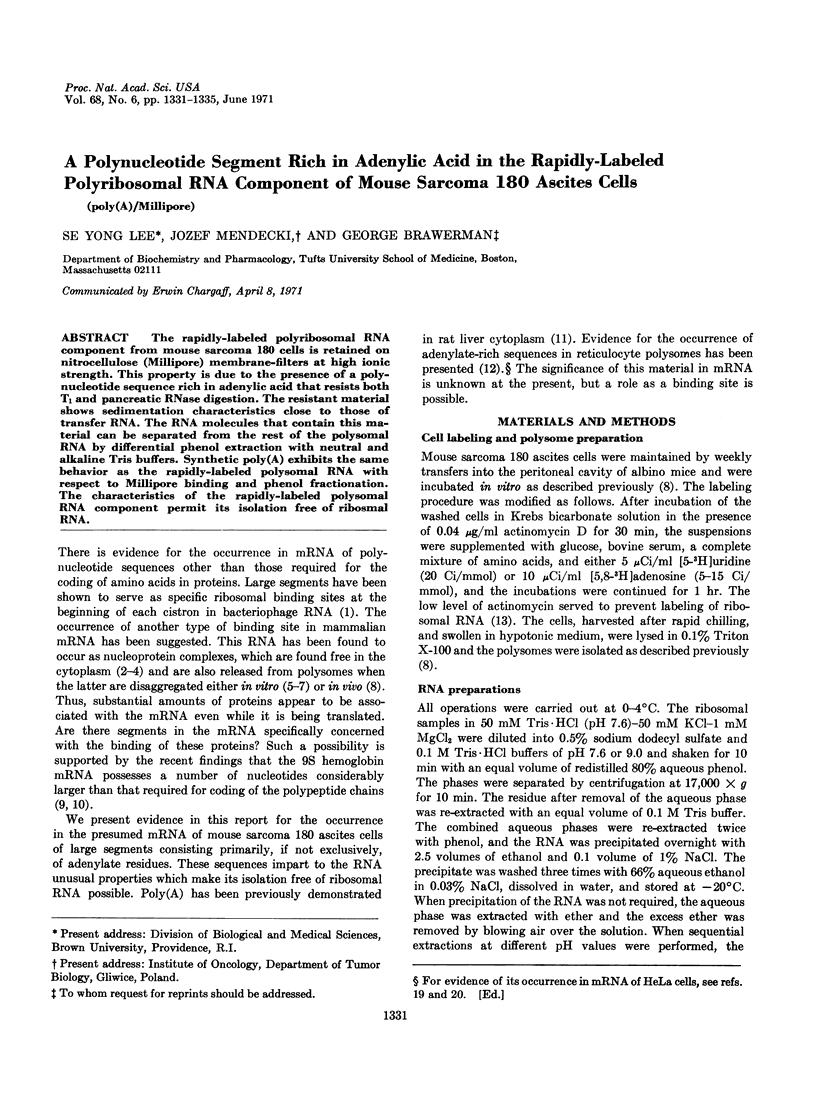
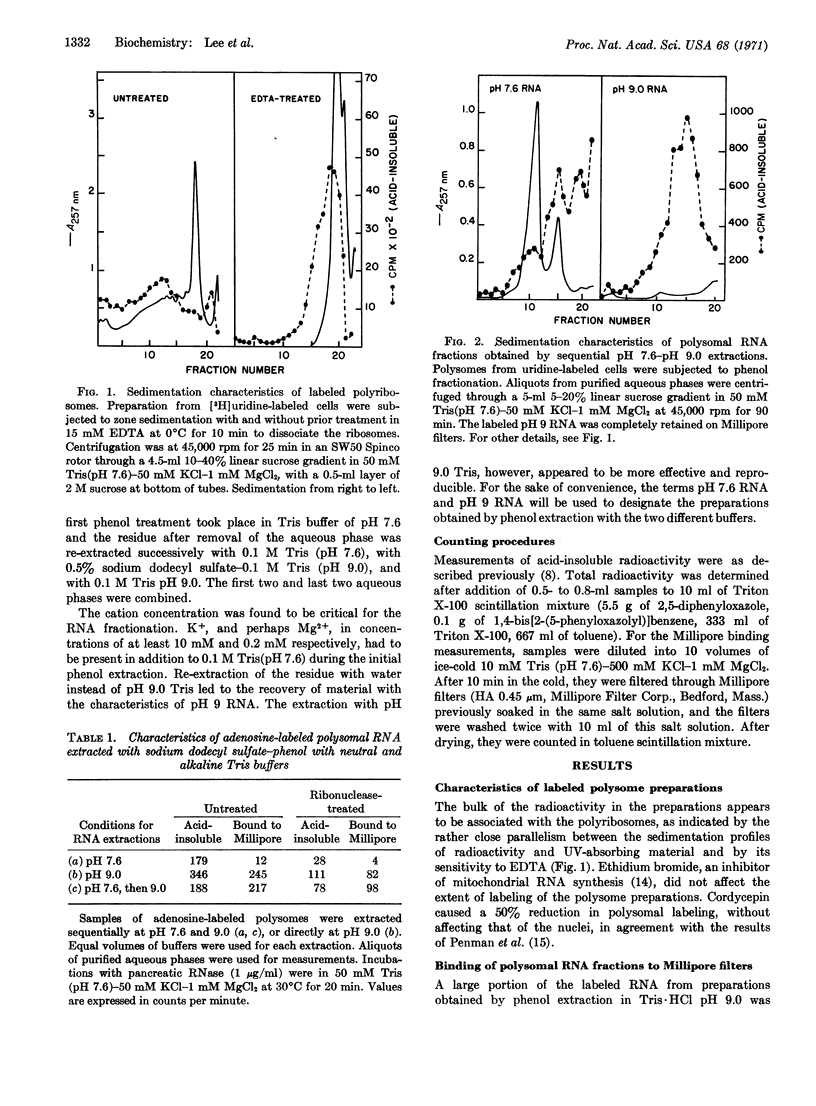
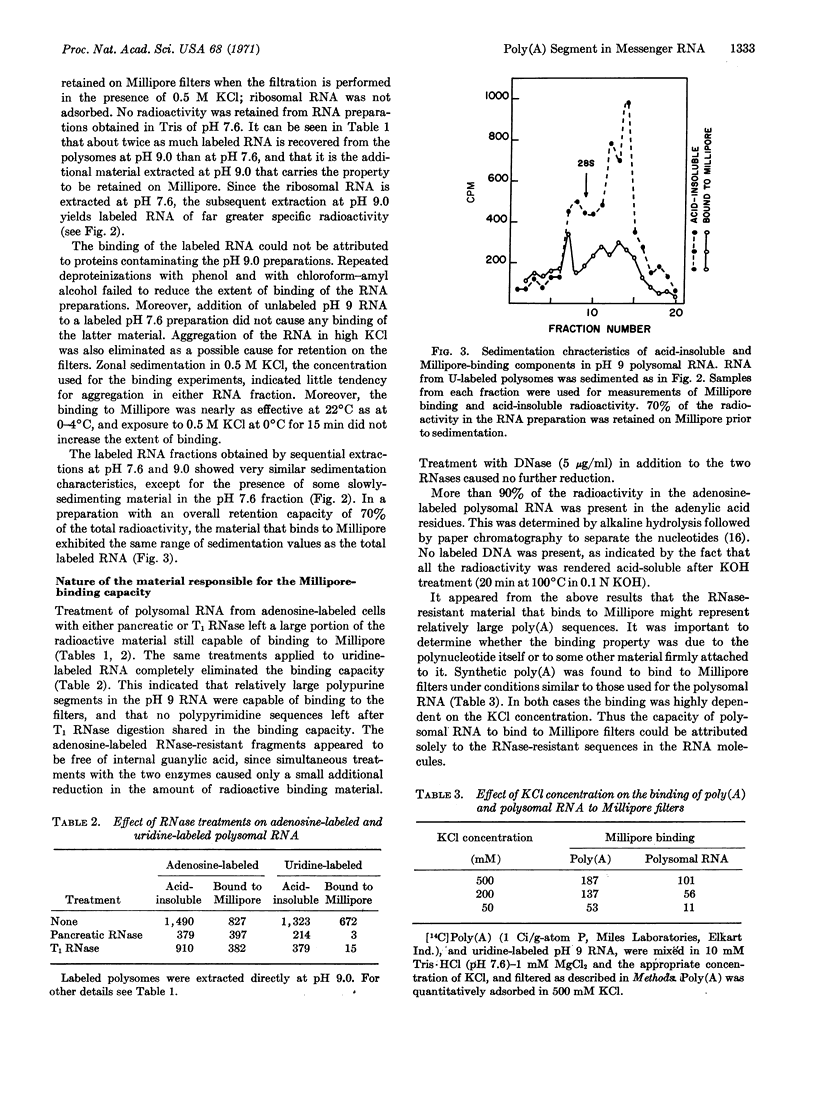
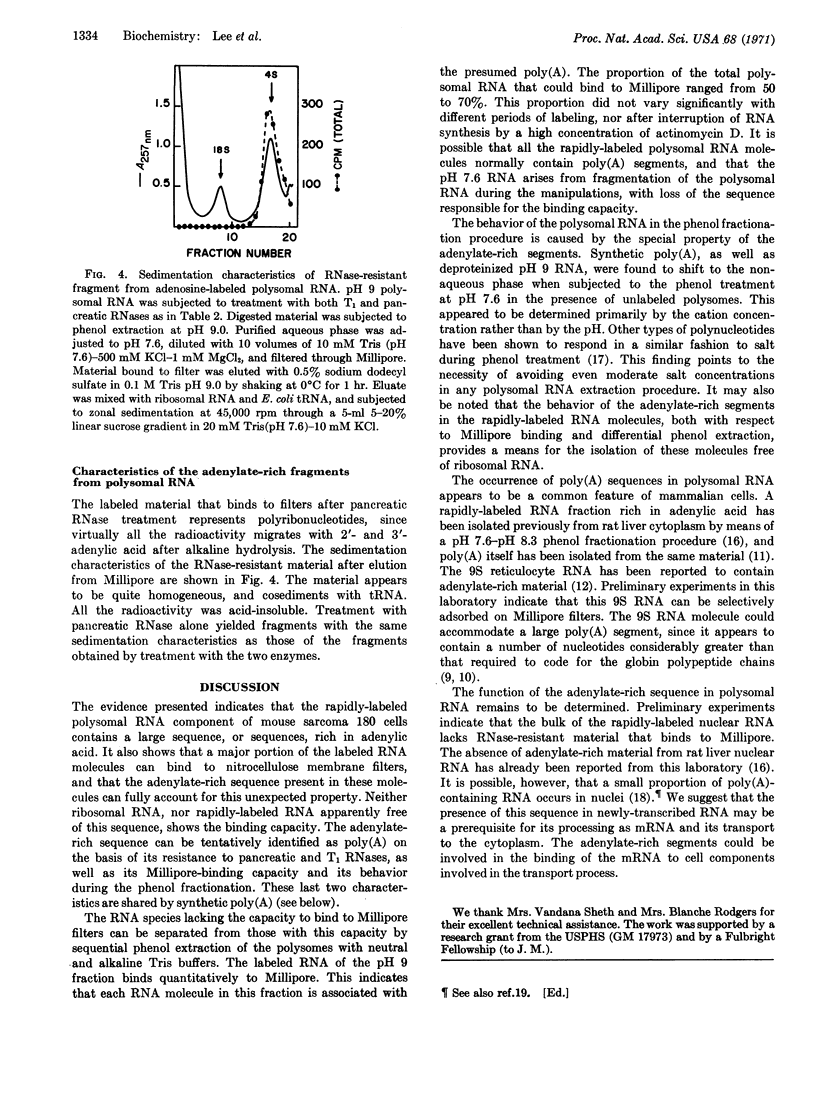
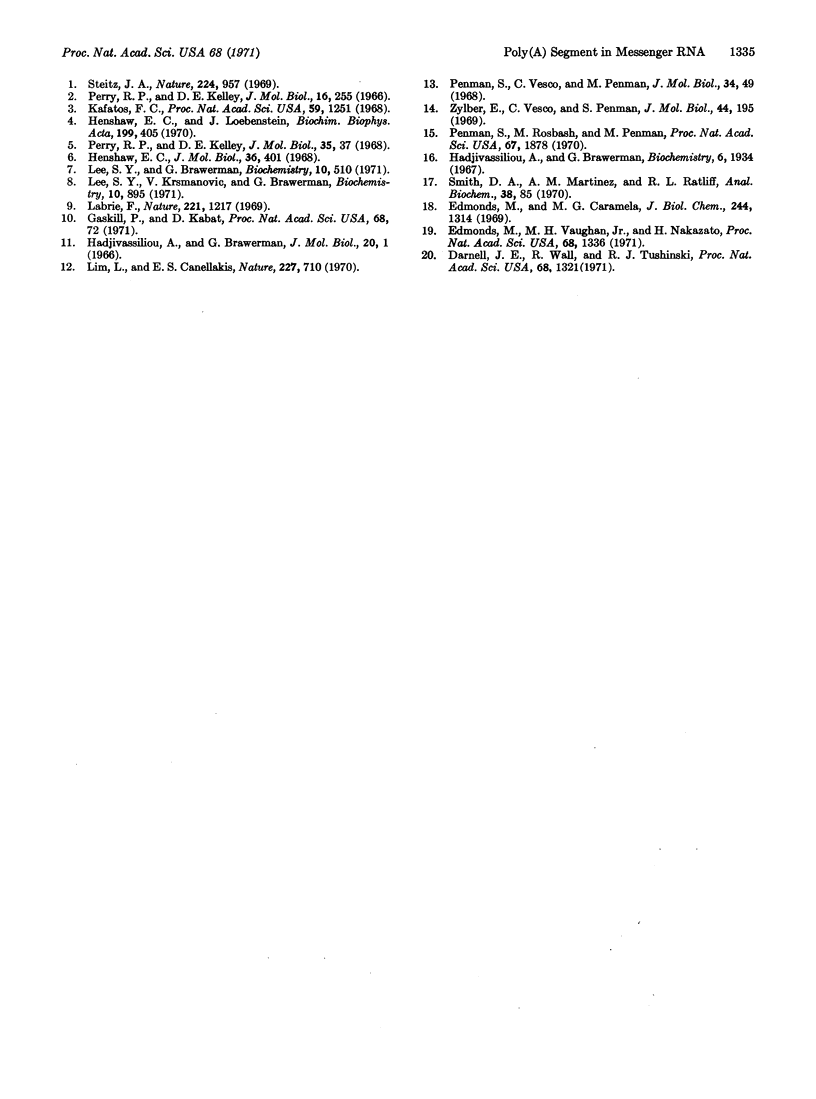
Selected References
These references are in PubMed. This may not be the complete list of references from this article.
- Darnell J. E., Wall R., Tushinski R. J. An adenylic acid-rich sequence in messenger RNA of HeLa cells and its possible relationship to reiterated sites in DNA. Proc Natl Acad Sci U S A. 1971 Jun;68(6):1321–1325. doi: 10.1073/pnas.68.6.1321. [DOI] [PMC free article] [PubMed] [Google Scholar]
- Edmonds M., Caramela M. G. The isolation and characterization of adenosine monophosphate-rich polynucleotides synthesized by Ehrlich ascites cells. J Biol Chem. 1969 Mar 10;244(5):1314–1324. [PubMed] [Google Scholar]
- Edmonds M., Vaughan M. H., Jr, Nakazato H. Polyadenylic acid sequences in the heterogeneous nuclear RNA and rapidly-labeled polyribosomal RNA of HeLa cells: possible evidence for a precursor relationship. Proc Natl Acad Sci U S A. 1971 Jun;68(6):1336–1340. doi: 10.1073/pnas.68.6.1336. [DOI] [PMC free article] [PubMed] [Google Scholar]
- Gaskill P., Kabat D. Unexpectedly large size of globin messenger ribonucleic acid. Proc Natl Acad Sci U S A. 1971 Jan;68(1):72–75. doi: 10.1073/pnas.68.1.72. [DOI] [PMC free article] [PubMed] [Google Scholar]
- Hadjivassiliou A., Brawerman G. Polyadenylic acid in the cytoplasm of rat liver. J Mol Biol. 1966 Sep;20(1):1–7. doi: 10.1016/0022-2836(66)90112-4. [DOI] [PubMed] [Google Scholar]
- Hadjivassiliou A., Brawerman G. Template and ribosomal ribonucleic acid components in the nucleus and the cytoplasm of rat liver. Biochemistry. 1967 Jul;6(7):1934–1941. doi: 10.1021/bi00859a008. [DOI] [PubMed] [Google Scholar]
- Henshaw E. C., Loebenstein J. Rapidly labeled, polydisperse RNA in rat-liver cytoplasm: evidence that it is contained in ribonucleoprotein particles of heterogeneous size. Biochim Biophys Acta. 1970 Feb 18;199(2):405–420. doi: 10.1016/0005-2787(70)90083-3. [DOI] [PubMed] [Google Scholar]
- Henshaw E. C. Messenger RNA in rat liver polyribosomes: evidence that it exists as ribonucleoprotein particles. J Mol Biol. 1968 Sep 28;36(3):401–411. doi: 10.1016/0022-2836(68)90164-2. [DOI] [PubMed] [Google Scholar]
- Kafatos F. C. Cytoplasmic particles carrying rapidly labeled RNA in developing insect epidermis. Proc Natl Acad Sci U S A. 1968 Apr;59(4):1251–1258. doi: 10.1073/pnas.59.4.1251. [DOI] [PMC free article] [PubMed] [Google Scholar]
- Labrie F. Isolation of an RNA with the properties of haemoglobin messenger. Nature. 1969 Mar 29;221(5187):1217–1222. doi: 10.1038/2211217a0. [DOI] [PubMed] [Google Scholar]
- Lee S. Y., Brawerman G. Pulse-labeled ribonucleic acid complexes released by dissociation of rat liver polysomes. Biochemistry. 1971 Feb 2;10(3):510–516. doi: 10.1021/bi00779a025. [DOI] [PubMed] [Google Scholar]
- Lee S. Y., Krsmanovic V., Brawerman G. Initiation of polysome formation in mouse sarcoma 180 ascites cells. Utilization of cytoplasmic messenger ribonucleic acid. Biochemistry. 1971 Mar 2;10(5):895–900. doi: 10.1021/bi00781a026. [DOI] [PubMed] [Google Scholar]
- Lim L., Canellakis E. S. Adenine-rich polymer associated with rabbit reticulocyte messenger RNA. Nature. 1970 Aug 15;227(5259):710–712. doi: 10.1038/227710a0. [DOI] [PubMed] [Google Scholar]
- Penman S., Rosbash M., Penman M. Messenger and heterogeneous nuclear RNA in HeLa cells: differential inhibition by cordycepin. Proc Natl Acad Sci U S A. 1970 Dec;67(4):1878–1885. doi: 10.1073/pnas.67.4.1878. [DOI] [PMC free article] [PubMed] [Google Scholar]
- Penman S., Vesco C., Penman M. Localization and kinetics of formation of nuclear heterodisperse RNA, cytoplasmic heterodisperse RNA and polyribosome-associated messenger RNA in HeLa cells. J Mol Biol. 1968 May 28;34(1):49–60. doi: 10.1016/0022-2836(68)90234-9. [DOI] [PubMed] [Google Scholar]
- Perry R. P., Kelley D. E. Buoyant densities of cytoplasmic ribonucleoprotein particles of mammalian cells: distinctive character of ribosome subunits and the rapidly labeled components. J Mol Biol. 1966 Apr;16(2):255–268. doi: 10.1016/s0022-2836(66)80171-7. [DOI] [PubMed] [Google Scholar]
- Perry R. P., Kelley D. E. Messenger RNA-protein complexes and newly synthesized ribosomal subunits: analysis of free particles and components of polyribosomes. J Mol Biol. 1968 Jul 14;35(1):37–59. doi: 10.1016/s0022-2836(68)80035-x. [DOI] [PubMed] [Google Scholar]
- Smith D. A., Martinez A. M., Ratliff R. L. Deproteinization with phenol of alternating polydeoxyadenylate-deoxythymidylate and other DNA-like polymers. Anal Biochem. 1970 Nov;38(1):85–89. doi: 10.1016/0003-2697(70)90157-0. [DOI] [PubMed] [Google Scholar]
- Steitz J. A. Polypeptide chain initiation: nucleotide sequences of the three ribosomal binding sites in bacteriophage R17 RNA. Nature. 1969 Dec 6;224(5223):957–964. doi: 10.1038/224957a0. [DOI] [PubMed] [Google Scholar]
- Zylber E., Vesco C., Penman S. Selective inhibition of the synthesis of mitochondria-associated RNA by ethidium bromide. J Mol Biol. 1969 Aug 28;44(1):195–204. doi: 10.1016/0022-2836(69)90414-8. [DOI] [PubMed] [Google Scholar]


